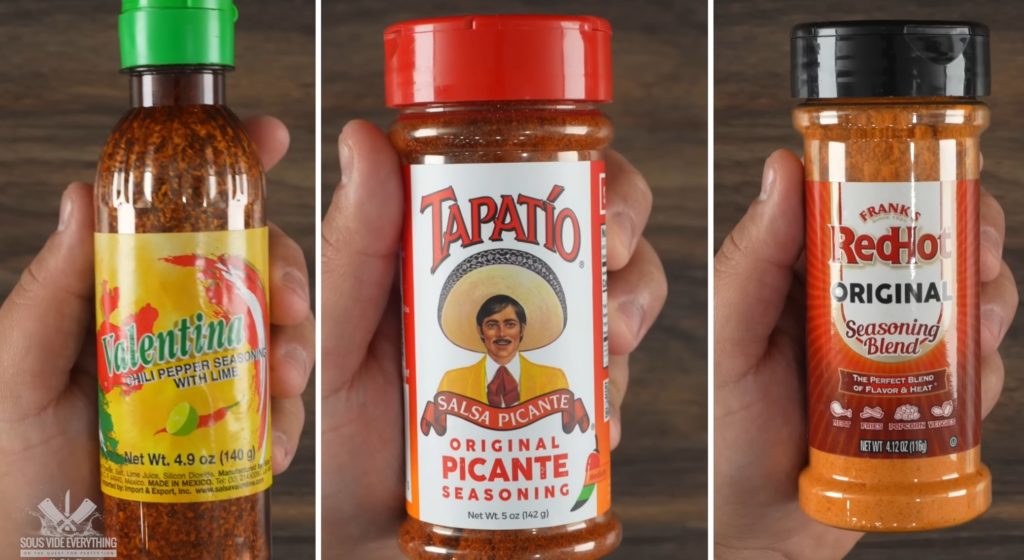Guga, the charismatic host of Sous Vide Everything, ignites the culinary scene by pairing steak and hot sauce, especially through the sous vide with hot sauce method. This innovative technique catapults classic tastes to unprecedented levels. By introducing hot sauce in powder form, Guga turns a gastronomic exploration into a tantalizing challenge of flavor and tenderness. Continue reading to discover his findings!
Disclaimer: Please be aware that some product links in this post might be affiliate links. This means we could earn a small commission at no additional cost to you if you click through and make a purchase. We include these links to support our site and to assist you in finding the products we discuss, though we encourage purchases based on your own research and preferences. We appreciate your support of our blog!
The Experiment: Elevating Sous Vide with Hot Sauce
In this sous vide with hot sauce experiment, Guga explored how powdered hot sauces like Frank’s Red Hot, Tapatio, and Valentina could elevate the sous vide steak experience. Selecting New York strip steaks for their ideal marbling and thickness set the stage for a high-stakes flavor trial. Post a foundational seasoning of salt, each steak was generously dusted with a different hot sauce powder, vacuum-sealed, and then sous vide cooked at 135°F for two hours.
Seasoning used in the video (with links to purchase):
Tasting and Results: A Spicy Verdict
The tasting session delved deep into the nuanced world of flavors, showcasing how each hot sauce powder uniquely enhanced the steaks. The steak seasoned with Tapatio powder was the first to be scrutinized, revealing an intriguing blend of vinegar zest and subtle citrus undertones that danced on the palate. This steak was a testament to Tapatio’s ability to infuse a layered complexity into the meat, enhancing its natural flavors without overwhelming them.
Next was the Frank’s Red Hot powdered steak, which emerged as a savory masterpiece. This steak distinguished itself with a rich, almost buttery Tabasco-like depth, complemented by a mild vinegar tang that elevated the beef’s umami qualities. The Frank’s Red Hot powder melded into the steak’s juices, creating a harmonious blend that was both bold and comforting.
The Valentina powder-coated steak, however, was the showstopper. It delivered a sophisticated spice level that was assertively flavorful yet astonishingly smooth. The Valentina powder imbued the steak with a unique smokiness and a hint of sweetness, rounding out the heat with a delicate balance. This steak was a celebration of Valentina’s signature robustness, proving that a perfect marriage of heat and flavor was not only possible but sublime.
Food Science Behind Sous Vide with Hot Sauce
Exploring the science behind the sous vide with hot sauce experiment not only unveils the culinary delight it offers but also highlights the fascinating interplay of food science elements that transform it into a revelation. This section breaks down the scientific marvels behind the process, from the heat-loving nature of capsaicin to the precision of sous vide cooking and the transformative power of the Maillard reaction. Each element plays a pivotal role in turning a simple piece of meat into an extraordinary culinary experience. Join us as we explore these concepts in digestible chunks, uncovering how science elevates flavor from the kitchen to the table.
Capsaicin’s Role in Steak Flavor
Capsaicin, the component that gives chili peppers their heat, is fat-soluble, making it a perfect match for the rich marbling of steak. This compound integrates into the steak’s fat, evenly spreading its spicy flavor without overpowering the meat’s natural taste. This process enhances the steak’s savory notes while introducing a comfortable warmth that enhances every bite.
Sous Vide Precision
Sous vide cooking plays a pivotal role in this culinary experiment. By maintaining a steady temperature of 135°F, the steak absorbs the hot sauce powders’ flavors more effectively, ensuring a perfectly cooked, tender result. This method prevents the breakdown of capsaicin, keeping the heat and flavor profile consistent throughout the meat.
The Maillard Reaction Magic
The final sear of the steak isn’t just for show; it’s a crucial step that invokes the Maillard reaction. This chemical interaction between amino acids and reducing sugars under heat creates a complex crust full of rich flavors. The hot sauce powders add to this complexity, contributing their own sugars and compounds for an even more delicious crust.
Combating Lipid Oxidation
During cooking, the steak’s fats oxidize, which can affect flavor. However, the antioxidants in chili peppers, such as vitamins A and C, can counteract these effects. Thus, the hot sauce powders do more than flavor the meat—they also help preserve its fresh taste by preventing undesirable oxidative flavors.
A Symphony of Science and Flavor
This experiment is a testament to how food science can transform simple ingredients into a culinary masterpiece. Understanding the interplay of capsaicin, sous vide cooking, and the Maillard reaction allows for the creation of a steak that’s not just cooked, but elevated to an art form. It’s a reminder of the fascinating stories that chemistry and heat write together in the kitchen.
Conclusion: A Culinary Adventure Worth Exploring
Guga’s journey with sous vide and hot sauce transcends a mere cooking experiment; it showcases how blending tradition with innovation can broaden the culinary science and flavor spectrum. This journey into the heart of flavor science not only expanded the culinary repertoire but also invited enthusiasts to explore the depth and breadth of seasoning potential.
As we reflect on this spicy endeavor, it’s clear that the world of steak seasoning is ripe for exploration. Armed with a bit of culinary curiosity, a dash of science, and a sprinkle of creativity, transforming a simple steak into a flavor-packed delicacy is within reach. So, why not venture into the aromatic world of powdered hot sauces? Guga’s experiment has paved the way for a spicy culinary adventure that’s just waiting to be explored. Check out our article on getting started with sous vide if you’re new to the process!

